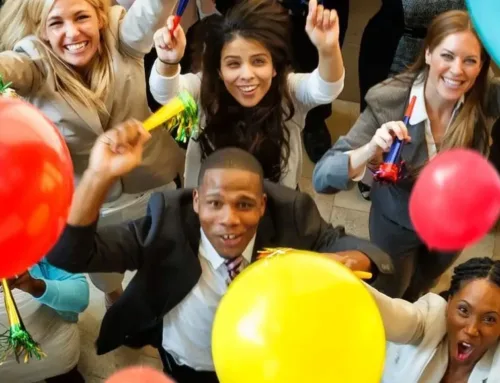Every business must adapt to the times to stay competitive. But consistent or unexpected organizational transition or transformation can trigger change fatigue symptoms within the workplace. So how can leaders recognize the early signs of fatigue in individuals and teams? And what actions can you take that will inspire others to cope with change and help them learn to embrace it?
Early signs of change fatigue are aggressive cynicism and employee burnout. The latter manifests in several ways, including emotional, mental, and physical exhaustion. Other signs are worker disengagement and increases in absenteeism. The best solution is prevention, to engage with those affected and ease symptoms without delay.
You can prevent change fatigue even if your business undergoes significant transformations. This piece looks at how to avert, address, and overcome this phenomenon with change management best practices. But first, an overview of what this fatigue is and how—if ignored—it has the potential to stall or even sabotage your initiatives.
What Is Change Fatigue And Its Causes?
Poorly executed change management initiatives can cause significant workplace disruption. It leads to a disgruntled, averse, and exhausted workforce that is unable or unwilling to accept new changes. And workplace complaints become louder and more frequent.
Effective change management leadership is critical for workplace harmony. But what happens if change leaders don’t prepare them for what’s to come or ignore employee concerns? When no one listens, there is distrust, resulting in worker and workplace disruption. Typical change fatigue symptoms materialize as anxiety, stress, and fear stemming from uncertainty. The outcome is distracted leadership and teams struggling to work effectively and efficiently.
Reasons for Organizational Change
The purpose for any amount of change is to improve organization performance and corporate growth. Organizational change occurs when a company decides to adjust or transform its business model. That could be its structure, strategies, or even core values. Other changes introduce new technology or seek to modernize company culture.
Established businesses rarely undergo change without careful consideration. Instead, most decisions result from economic factors, growth, innovative leadership, or societal changes.
EWF Executive Non-Compete Forums
In difficult situations it helps to have a sounding board, an inner circle of peers who can help you find a path to navigate through challenges. EWF’s non-compete Executive Forums offers women in senior leadership positions a safe, confidential environment to explore your unique challenges with like-minded women.
Learn More About EWF’s Executive Forums
Change Saturation Vs Change Fatigue
Change saturation ensues when organizational changes exceed the capacity to implement them. In other words, too many changes happen too fast for an individual, group, or organization to handle. The result is workplace turmoil, where bottlenecks slow progress, the occurrence of mistakes skyrocket and often cause widespread disruption.
The 2008 Prosci Change Saturation ModelTM illustrates the point:
So, change saturation is when disruption exceeds the capacity to handle it. And change fatigue results from change saturation, which often leads to change resistance.
Potential Short-term Impact
Even well-executed changes in the workplace have some short-term impact. It can take time to adapt to new systems and procedures. Some people welcome change, but resistance is common because humans are hardwired to see it as a threat. Consequently, employees may feel uncertainty and insecure for a while, leading to reduced productivity. But with an informed, engaged workforce and well-planned changes, the impact will be short-lived as workers acclimatize [1].
Potential Long-term Impact
The long-term impact of worker fatigue can drag your organization down. Exhausted employees can burn out, become perpetually weary and eventually lose motivation. As a result, they are less productive and take more time off. Many will quit their jobs or consider switching employers for a better work situation, which isn’t good for business. Workplace dissatisfaction also damages morale, and employees may lose focus on their roles [2].
Recognizable Symptoms
Worker fatigue doesn’t just happen in a flash; it festers over time. So the sooner you recognize the symptoms, the faster you can act to combat them. Fortunately, reactions to corporate changes are predictable, including how fatigue manifests from change saturation.
Here are seven symptoms that suggest workers are suffering from workplace changes:
- Noise: Persistent complaints about the new changes
- Apathy: Noticeable lack of interest, dwindling enthusiasm, or little concern
- Burnout: Workers are visibly exhausted, mentally and or physically
- Stress: Increasingly irritable and anxious
- Resistance: Continually pushing back on change
- Negativity: Open display of sarcasm, uncertainty, and distrust
- Skepticism: Unconvinced that changes will succeed
These symptoms are unlikely to improve on their own, they are more likely to worsen if left alone. Change leaders must take a proactive approach to addressing these symptoms and reducing change fatigue. It’s the only way to help employees embrace change and overcome the situation.
5 Common Reactions to Change Fatigue Study
A 2022 study identified five common ways workplace fatigue affected employees. Worker retention and talent scarcity are already major concerns for organizations at this time. And workplace changes are adding to these issues, as the chart below illustrates.
Workplace Change Affects People Differently
Organizational change can affect everyone, from C-suite executives to entry-level employees. However, research shows that people in certain roles have higher exposure to change saturation. Those most at risk are often those furthest from the decision makers implementing the change, such as front-line employees and people managers. Think sales personnel, customer service staff, and HR.
How change fatigue manifests itself depends on the employee’s ability to cope. Previous change implementation experiences can very much color a person’s response to change saturation and change fatigue.
Underlying Causes According to Research
This type of fatigue is primarily the result of ill-prepared workers exposed to high-impact, long-term changes. Around 70% of change programs fail to realize their goals. Much of this is due to employee resistance. But resistance only exists because change initiatives lack leadership support and team cohesion.
It doesn’t have to be like this. Clear communication and preparation for implementing change is vital to successful change implementation. Overcoming resistance often comes down to everyone understanding what is changing in the organization and why. The second half is preparing employees for the change so they are confident in their ability to navigate change successfully. Fundamentally, employees feel engaged in the change process. Yet many organizations do not engage those most affected by their change plans [3] [4].
Why Employee Engagement Matters
The UK MacLeod report found that employee engagement yields better results for people and organizations. The findings showed that an engaged workforce had 18% higher productivity and a 4x boost in financial performance. The investigation also revealed that an engaged workforce achieves better customer advocacy by up to 12% [5].
How to Address and Relieve Change Fatigue?
Companies need to acknowledge that change fatigue is real and requires priority. And the way to address these issues begins with trust and team cohesion. This is your foundation for creating stronger resilience. Moreover, communication must be open, honest, and continuous. Anything less risks disengaging those you are trying to support.
When one feels supported by change leaders, there develops a shared sense of purpose. That’s why recognizing employee contributions and celebrating small victories go a long way. So, engaging with workers inspires re-engagement and faster recovery from fatigue.
When HR Ignores Change Fatigue Symptoms
What happens if human resource managers ignore symptoms of employee change fatigue? What is the worst possible outcome from employer and employee perspectives?
The Employer’s Perspective
You may end up with an unmotivated, uninspired, cynical population. Employees will disengage and scoff at changes they can’t adapt to. Other potential issues are a rise in absenteeism, low employee retention, and a difficulty attracting high-quality prospects to the organization.
The Employee’s Perspective
Ignoring change fatigue in your employees has consequences for their welfare. They will start to experience a disruptive, unhappy work life. They can suffer from stress, anxiety, concerns over personal health and safety, and job insecurity. Mental and emotional exhaustion may cause them to take more time off work and disrupt personal and professional relationships.
Employees who feel unseen and unheard at their workplace will disengage and begin seeking alternative employment opportunities that better suit their needs.
How to Prevent Worker Fatigue?
Most organizational change initiatives fail when those leading them are in the dark. They fail to grasp the importance of getting everyone on board who needs to be engaged. That includes those who stand to be most affected by the changes.
Conducting a major organizational transformation will create some level of change fatigue. Even so, you can vastly reduce it and shorten the impact. And you do that by forming and implementing a well-considered, structured change management initiative (see next).
People and Strategies That Help
Employee engagement and transformational leadership greatly mitigate change fatigue. Transformational leaders have a track record of instigating successful change initiatives. They get things done and inspire those they lead towards the desired results. Thus, transformational leaders have a positive impact on motivation, engagement, and performance levels, even through change implementation.
The ADKAR Model of Change Management
One way to keep focused and avoid change fatigue is to follow the ADKAR Model of Change Management. It’s a tool that corporations use to analyze and implement change initiatives. US entrepreneur Jeff Hiatt developed the 5-element ADKAR Model over two decades ago. It is the result of studying the different change patterns of over 700 US organizations.
| Awareness | Make affected parties aware of the need for change |
| Desire | Encourage participation and desire to support change |
| Knowledge | Detail how to change |
| Ability | The skills and ability to implement the change |
| Reinforcement | Strategies to sustain & reinforce change |
Working through a structured framework makes it much easier to focus on change initiative challenges. It helps you outline clear goals and visualize successful outcomes. Structure enables you to drive individual change and realize organizational results without burnout.
Closing Comments
Failed change initiatives and subsequent fatigue continue to be an issue for many US organizations. It affects both employee and organizational performance. Still, it is possible to address and overcome change fatigue by renewing trust in leadership and change agents. But with a structured plan and cohesive workplace, you will reduce or prevent these issues from occurring in the first place.
EWF Corporate Programs Help Transformational Leaders Thrive
EWF custom corporate programming can help transformational leaders like you prosper at an organizational and personal level. We help shape transformational leaders who are not only great for business but also for themselves, their families, their communities, and the world we’re building together. EWF’s corporate programs equip and empower you to drive organizational advancement and navigate an ever-changing world.
More About EWF’s Programming Ecosystem for Today’s Transformational Leaders
Change Fatigue Resource Links
- https://www.emersonhc.com/change-management/people-hard-wired-resist-change
- https://www.tandfonline.com/change-fatigue-and-exhaustion/
- https://www.mckinsey.com/featured-insights/leadership/changing-change-management
- https://static1.squarespace.com/ChangeCommunicationsSurvey/
- https://engageforsuccess.org/MacLeod-report/




